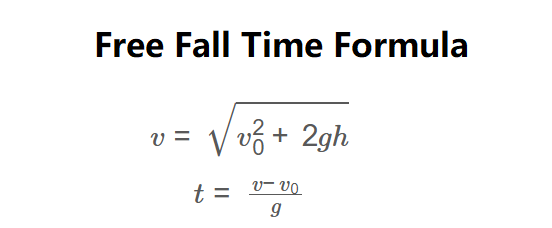1. What is the Free Fall Time Calculator?
Definition: This calculator computes the time of fall (\( t \)) and final velocity (\( v \)) of an object in free fall based on gravitational acceleration (\( g \)), initial velocity (\( v_0 \)), and height (\( h \)).
Purpose: It is used in physics, engineering, and education to analyze the motion of objects under gravity.
2. How Does the Calculator Work?
The calculator uses the following kinematic equations:
\( v = \sqrt{v_0^2 + 2 g h} \)
\( t = \frac{v - v_0}{g} \)
Where:
- \( g \): Gravitational acceleration (m/s², ft/s²);
- \( v_0 \): Initial velocity (m/s, km/h, ft/s, mph, kn, km/s, mi/s, ft/min, m/min);
- \( h \): Height (cm, m, km, in, ft, yd, mi);
- \( v \): Final velocity (m/s, km/h, ft/s, mph, kn, km/s, mi/s, ft/min, m/min);
- \( t \): Time of fall (s, min).
Steps:
- Enter the gravitational acceleration (\( g \)) with its unit.
- Enter the initial velocity (\( v_0 \)) with its unit.
- Enter the height (\( h \)) with its unit.
- Convert all inputs to base SI units (m/s² for \( g \), m/s for \( v_0 \), m for \( h \)).
- Calculate the final velocity using \( v = \sqrt{v_0^2 + 2 g h} \).
- Calculate the time using \( t = \frac{v - v_0}{g} \).
- Convert the results to the selected output units.
- Display the results, formatted in scientific notation if the absolute value is less than 0.001, otherwise with 4 decimal places.
3. Importance of Free Fall Time and Velocity Calculation
Calculating free fall time and velocity is crucial for:
- Physics Education: Understanding motion under gravity.
- Engineering Safety: Designing fall protection systems.
- Astronomy: Analyzing orbital mechanics.
4. Using the Calculator
Example 1: Calculate the time of fall and final velocity with \( g = 9.81 \, \text{m/s}^2 \), \( v_0 = 0 \, \text{m/s} \), \( h = 19.62 \, \text{m} \):
- Gravitational Acceleration: \( g = 9.81 \, \text{m/s}^2 \);
- Initial Velocity: \( v_0 = 0 \, \text{m/s} \);
- Height: \( h = 19.62 \, \text{m} \);
- Final Velocity: \( v = \sqrt{0^2 + 2 \cdot 9.81 \cdot 19.62} = \sqrt{384.9644} \approx 19.62 \, \text{m/s} \);
- Time: \( t = \frac{19.62 - 0}{9.81} \approx 2 \, \text{s} \);
- Result (Velocity in m/s): \( v = 19.6200 \, \text{m/s} \);
- Result (Time in seconds): \( t = 2.0000 \, \text{s} \).
Example 2: Calculate the time of fall and final velocity with \( g = 32.2 \, \text{ft/s}^2 \), \( v_0 = 10 \, \text{ft/s} \), \( h = 100 \, \text{ft} \):
- Gravitational Acceleration: \( g = 32.2 \, \text{ft/s}^2 \times 0.3048 = 9.81856 \, \text{m/s}^2 \);
- Initial Velocity: \( v_0 = 10 \, \text{ft/s} \times 0.3048 = 3.048 \, \text{m/s} \);
- Height: \( h = 100 \, \text{ft} \times 0.3048 = 30.48 \, \text{m} \);
- Final Velocity: \( v = \sqrt{3.048^2 + 2 \cdot 9.81856 \cdot 30.48} = \sqrt{9.292 + 598.223} \approx 24.463 \, \text{m/s} \);
- Time: \( t = \frac{24.463 - 3.048}{9.81856} \approx 2.185 \, \text{s} \);
- Result (Velocity in ft/s): \( v = 80.2625 \, \text{ft/s} \);
- Result (Time in minutes): \( t = 0.0364 \, \text{min} \).
5. Frequently Asked Questions (FAQ)
Q: What is free fall?
A: Free fall is the motion of an object under the influence of gravity alone, with no other forces (e.g., air resistance) acting on it.
Q: Why calculate both velocity and time?
A: Knowing both the final velocity and time of fall provides a complete picture of the object’s motion, useful for safety and design applications.
Q: Does this calculator account for air resistance?
A: No, this calculator assumes ideal conditions with no air resistance.
Free Fall Time Calculator© - All Rights Reserved 2025
 Home
Home
 Back
Back
